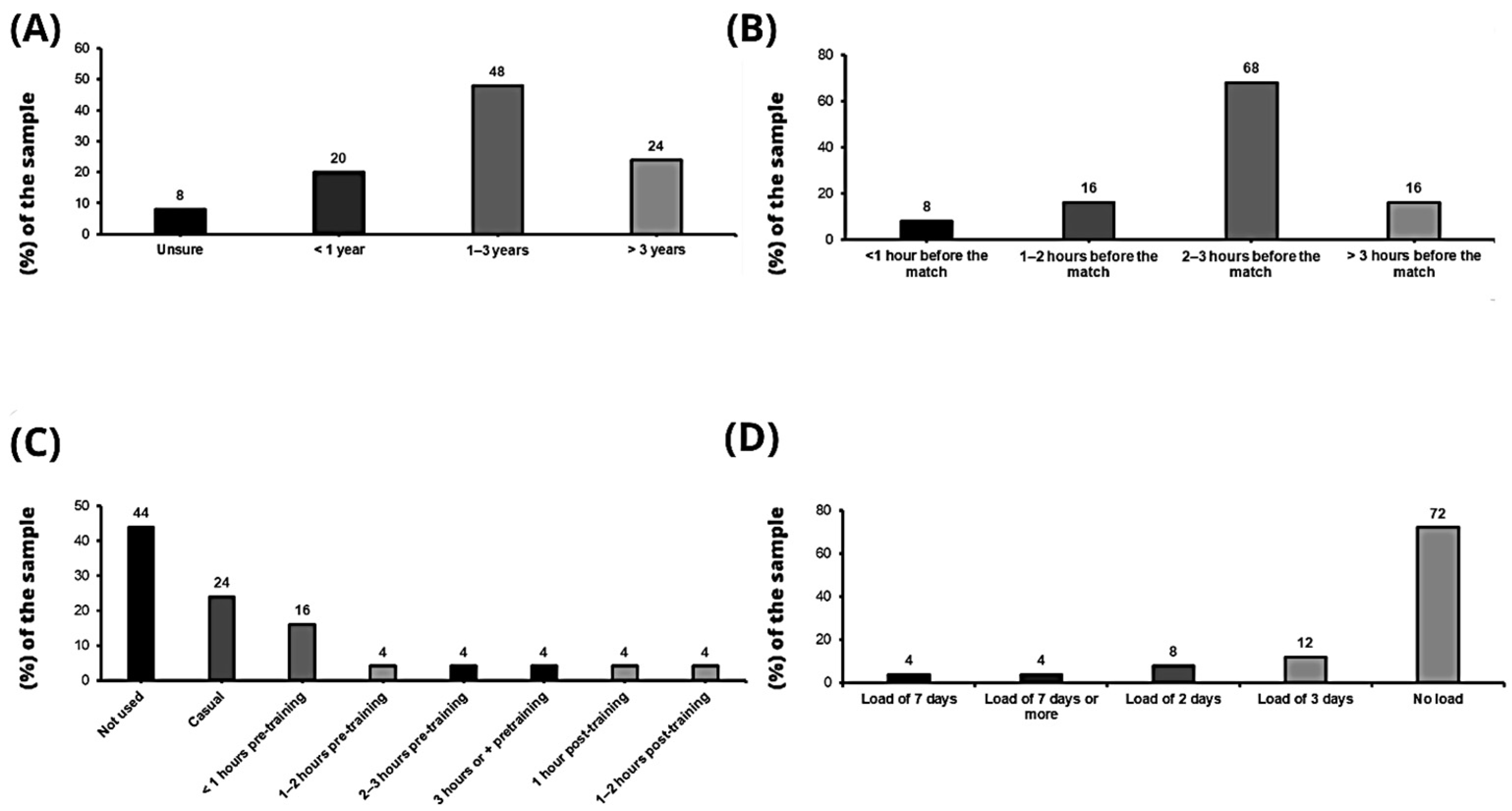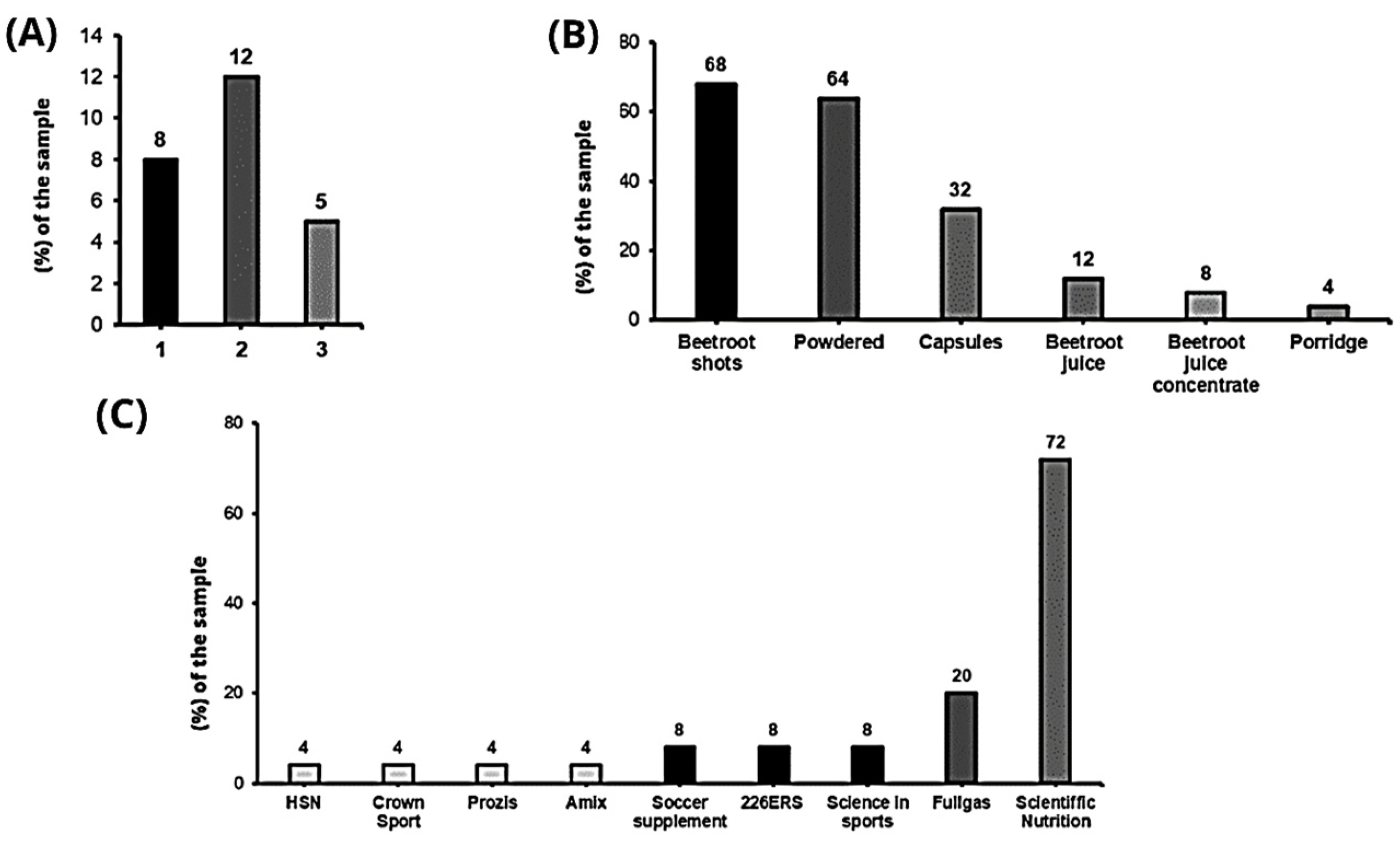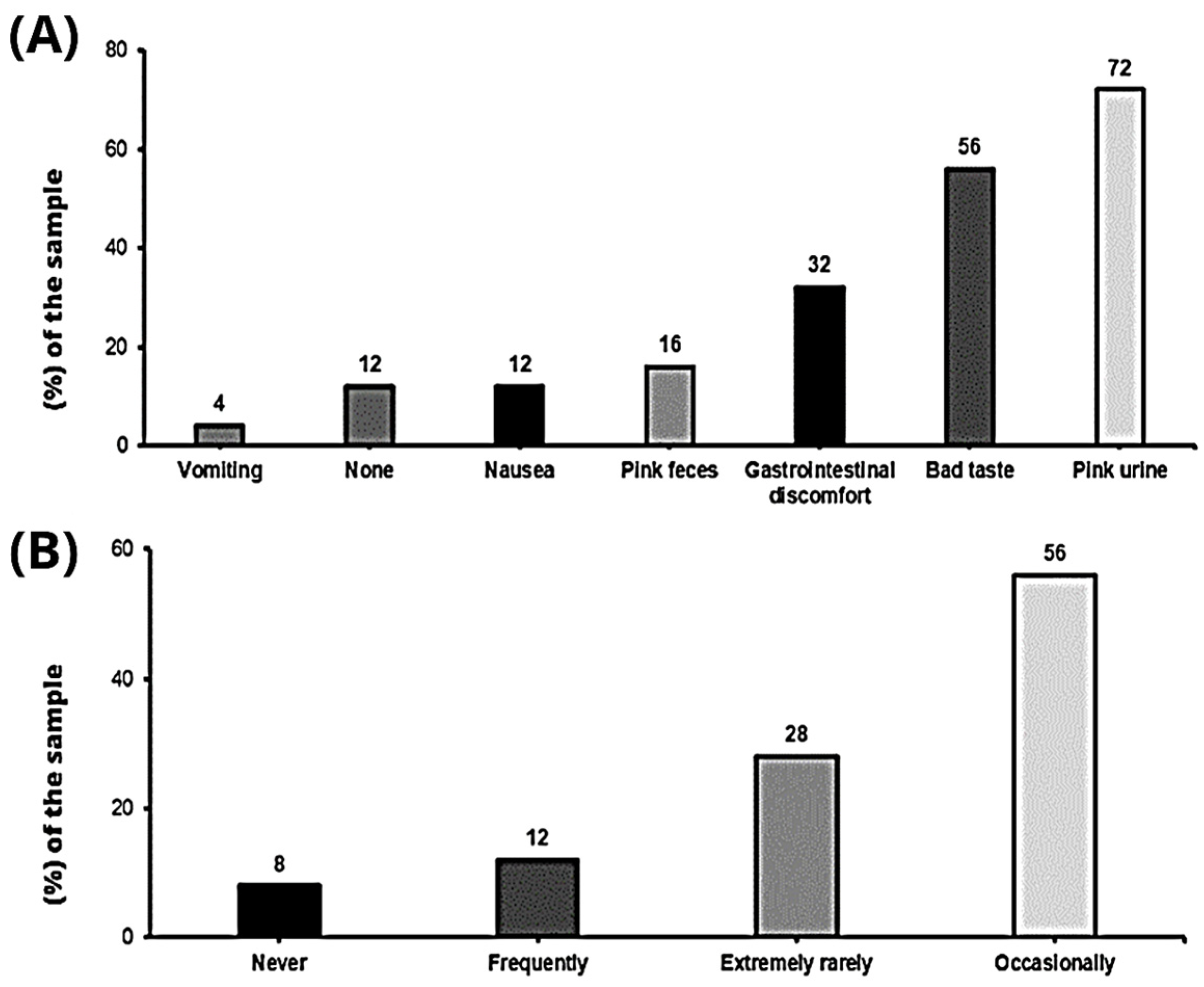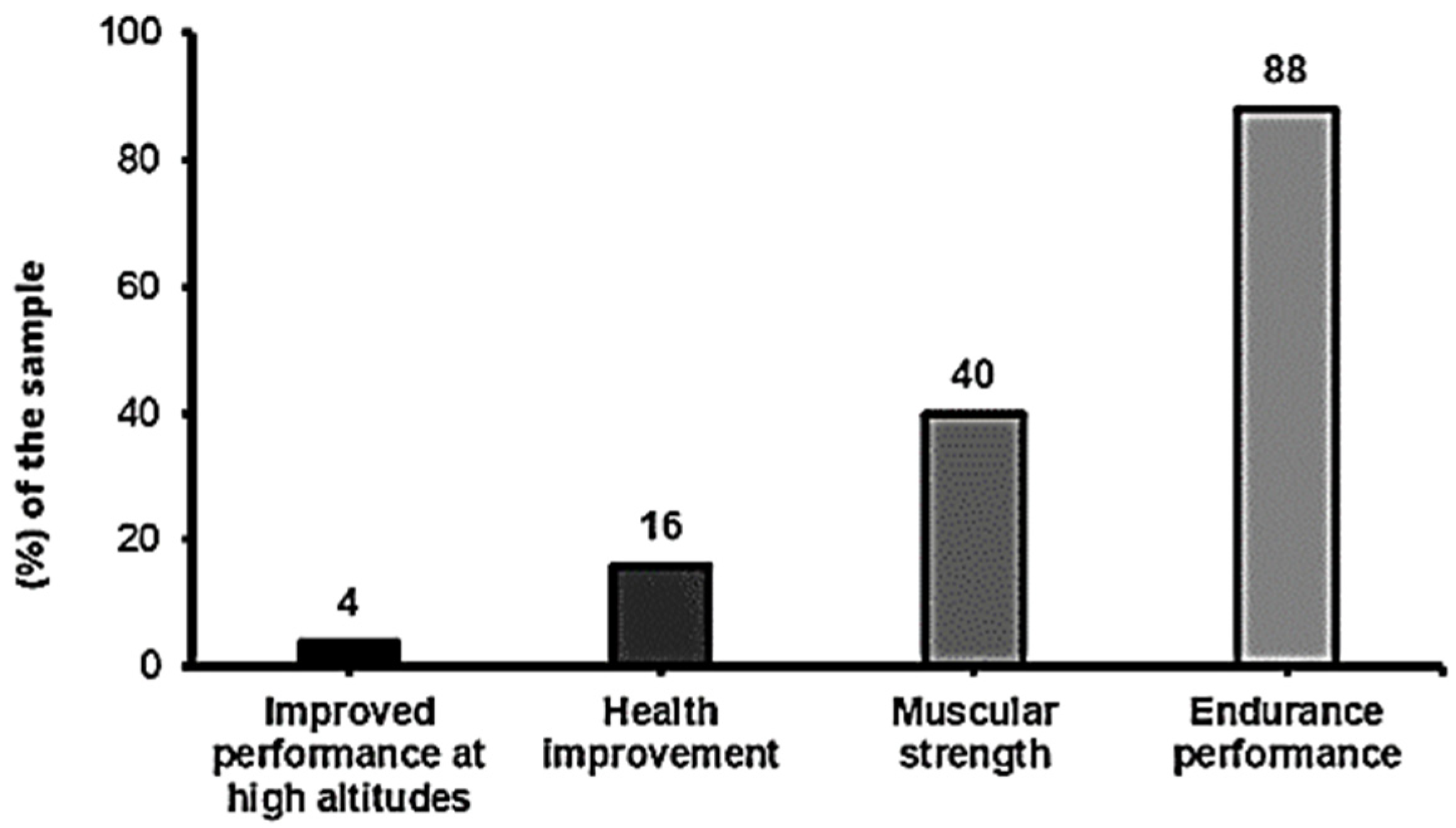Nitric Oxide in the Field: Prevalence and Use of Nitrates by Dietitians and Nutritionists in Spanish Elite Soccer
Abstract
1. Introduction
2. Materials and Methods
2.1. Study Design
2.2. Participants
2.3. Survey Design
2.4. Statistical Analysis
3. Results
4. Discussion
4.1. Nitrate Consumption in Elite Soccer
4.2. Adverse Effects of Nitrate Consumption
4.3. Perception of Nitrates as an Ergogenic Aid
4.4. Limitations
5. Conclusions
Supplementary Materials
Author Contributions
Funding
Institutional Review Board Statement
Informed Consent Statement
Data Availability Statement
Acknowledgments
Conflicts of Interest
Abbreviations
References
- Barnes, C.; Archer, D.T.; Hogg, B.; Bush, M.; Bradley, P.S. The Evolution of Physical and Technical Performance Parameters in the English Premier League. Int. J. Sports Med. 2014, 35, 1095–1100. [Google Scholar] [CrossRef]
- Leon, H.; Jiménez, A.; Ramirez Villada, J. Demandas Fisiológicas y Psicológicas en el Fútbol. Rev. Cuerpo Cult. Mov. 2011, 1, 45–55. [Google Scholar] [CrossRef][Green Version]
- Bengtsson, H.; Ekstrand, J.; Hägglund, M. Muscle Injury Rates in Professional Football Increase with Fixture Congestion: An 11-Year Follow-up of the UEFA Champions League Injury Study. Br. J. Sports Med. 2013, 47, 743–747. [Google Scholar] [CrossRef]
- Anderson, L.; Orme, P.; Di Michele, R.; Close, G.L.; Morgans, R.; Drust, B.; Morton, J.P. Quantification of Training Load during One-, Two- and Three-Game Week Schedules in Professional Soccer Players from the English Premier League: Implications for Carbohydrate Periodisation. J. Sports Sci. 2016, 34, 1250–1259. [Google Scholar] [CrossRef]
- Collins, J.; Maughan, R.J.; Gleeson, M.; Bilsborough, J.; Jeukendrup, A.; Morton, J.P.; Phillips, S.M.; Armstrong, L.; Burke, L.M.; Close, G.L.; et al. UEFA Expert Group Statement on Nutrition in Elite Football. Current Evidence to Inform Practical Recommendations and Guide Future Research. Br. J. Sports Med. 2021, 55, 416. [Google Scholar] [CrossRef]
- Anderson, L.; Drust, B.; Close, G.L.; Morton, J.P. Physical Loading in Professional Soccer Players: Implications for Contemporary Guidelines to Encompass Carbohydrate Periodization. J. Sports Sci. 2022, 40, 1000–1019. [Google Scholar] [CrossRef]
- Bangsbo, J.; Mohr, M.; Krustrup, P. Physical and Metabolic Demands of Training and Match-Play in the Elite Football Player. J. Sports Sci. 2006, 24, 665–674. [Google Scholar] [CrossRef]
- Stølen, T.; Chamari, K.; Castagna, C.; Wisløff, U. Physiology of Soccer: An Update. Sports Med. 2005, 35, 501–536. [Google Scholar] [CrossRef]
- Dolci, F.; Hart, N.H.; Kilding, A.E.; Chivers, P.; Piggott, B.; Spiteri, T. Physical and Energetic Demand of Soccer: A Brief Review. Strength Cond. J. 2020, 42, 70–77. [Google Scholar] [CrossRef]
- Blasco Redondo, R.; Contreras Fernández, C.J.; de Teresa Galván, C.; del Valle Soto, M.; Franco Bonafonte, L.; García Gabarra, A.; Gaztañaga Aurrekoetxea, T.; Manonelles Marqueta, P.; Manuz González, B.; Palacios Gil-Antuñano, N.; et al. Suplementos nutricionales para el deportista. Ayudas ergogénicas en el deporte—2019. Documento de consenso de la Sociedad Española de Medicina del Deporte. Arch. Med. Deporte Rev. Fed. Esp. Med. Deporte Confed. Iberoam. Med. Deporte 2019, 36, 1–114. [Google Scholar]
- Martínez-Sanz, J.M.; Sospedra, I.; Ortiz, C.M.; Baladía, E.; Gil-Izquierdo, A.; Ortiz-Moncada, R. Intended or Unintended Doping? A Review of the Presence of Doping Substances in Dietary Supplements Used in Sports. Nutrients 2017, 9, 1093. [Google Scholar] [CrossRef]
- Australian Sports Commission. Jurisdiction=Commonwealth of A. corporateName=Australian S. Group A. Available online: https://www.ais.gov.au/nutrition/supplements/group_a (accessed on 19 May 2023).
- Shannon, O.M.; Allen, J.D.; Bescos, R.; Burke, L.; Clifford, T.; Easton, C.; Gonzalez, J.T.; Jones, A.M.; Jonvik, K.L.; Larsen, F.J.; et al. Dietary Inorganic Nitrate as an Ergogenic Aid: An Expert Consensus Derived via the Modified Delphi Technique. Sports Med. 2022, 52, 2537–2558. [Google Scholar] [CrossRef]
- Van der Avoort, C.M.T.; Van Loon, L.J.C.; Hopman, M.T.E.; Verdijk, L.B. Increasing Vegetable Intake to Obtain the Health Promoting and Ergogenic Effects of Dietary Nitrate. Eur. J. Clin. Nutr. 2018, 72, 1485–1489. [Google Scholar] [CrossRef]
- Alzahrani, H.S.; Jackson, K.G.; Hobbs, D.A.; Lovegrove, J.A. The Role of Dietary Nitrate and the Oral Microbiome on Blood Pressure and Vascular Tone. Nutr. Res. Rev. 2021, 34, 222–239. [Google Scholar] [CrossRef]
- Nyakayiru, J.; Jonvik, K.L.; Trommelen, J.; Pinckaers, P.J.M.; Senden, J.M.; van Loon, L.J.C.; Verdijk, L.B. Beetroot Juice Supplementation Improves High-Intensity Intermittent Type Exercise Performance in Trained Soccer Players. Nutrients 2017, 9, 314. [Google Scholar] [CrossRef]
- Daab, W.; Bouzid, M.A.; Lajri, M.; Bouchiba, M.; Saafi, M.A.; Rebai, H. Chronic Beetroot Juice Supplementation Accelerates Recovery Kinetics Following Simulated Match Play in Soccer Players. J. Am. Coll. Nutr. 2021, 40, 61–69. [Google Scholar] [CrossRef]
- Berjisian, E.; McGawley, K.; Saunders, B.; Domínguez, R.; Koozehchian, M.S.; de Oliveira, C.V.C.; Rafiei, R.; Miraftabi, H.; Sarshin, A.; Naderi, A. Acute Effects of Beetroot Juice and Caffeine Co-Ingestion during a Team-Sport-Specific Intermittent Exercise Test in Semi-Professional Soccer Players: A Randomized, Double-Blind, Placebo-Controlled Study. BMC Sports Sci. Med. Rehabil. 2022, 14, 52. [Google Scholar] [CrossRef]
- Gallardo, E.J.; Coggan, A.R. What’s in Your Beet Juice? Nitrate and Nitrite Content of Beet Juice Products Marketed to Athletes. Int. J. Sport Nutr. Exerc. Metab. 2019, 29, 345–349. [Google Scholar] [CrossRef]
- Tallis, J.; Clarke, N.; Morris, R.; Richardson, D.; Ellis, M.; Eyre, E.; Duncan, M.; Noon, M. The Prevalence and Practices of Caffeine Use as an Ergogenic Aid in English Professional Soccer. Biol. Sport 2021, 38, 525–534. [Google Scholar] [CrossRef]
- Thompson, C.; Vanhatalo, A.; Kadach, S.; Wylie, L.J.; Fulford, J.; Ferguson, S.K.; Blackwell, J.R.; Bailey, S.J.; Jones, A.M. Discrete Physiological Effects of Beetroot Juice and Potassium Nitrate Supplementation Following 4-Wk Sprint Interval Training. J. Appl. Physiol. 2018, 124, 1519–1528. [Google Scholar] [CrossRef]
- Flueck, J.L.; Bogdanova, A.; Mettler, S.; Perret, C. Is Beetroot Juice More Effective than Sodium Nitrate? The Effects of Equimolar Nitrate Dosages of Nitrate-Rich Beetroot Juice and Sodium Nitrate on Oxygen Consumption during Exercise. Appl. Physiol. Nutr. Metab. Physiol. Appl. Nutr. Metab. 2016, 41, 421–429. [Google Scholar] [CrossRef] [PubMed]
- Silva, K.V.C.; Costa, B.D.; Gomes, A.C.; Saunders, B.; Mota, J.F. Factors That Moderate the Effect of Nitrate Ingestion on Exercise Performance in Adults: A Systematic Review with Meta-Analyses and Meta-Regressions. Adv. Nutr. 2022, 13, 1866–1881. [Google Scholar] [CrossRef] [PubMed]
- Roumeliotis, C.; Siomos, A.S.; Gerasopoulos, D. Comparative Nutritional and Antioxidant Compounds of Organic and Conventional Vegetables during the Main Market Availability Period. Nitrogen 2021, 2, 18–29. [Google Scholar] [CrossRef]
- Aesan—Agencia Española de Seguridad Alimentaria y Nutrición. Available online: https://www.aesan.gob.es/AECOSAN/web/para_el_consumidor/ampliacion/nitratos_hortalizas.htm (accessed on 26 March 2021).
- Subramanian, D.; Gupta, S. Pharmacokinetic Study of Amaranth Extract in Healthy Humans: A Randomized Trial. Nutrition 2016, 32, 748–753. [Google Scholar] [CrossRef]
- Moore, A.N.; Haun, C.T.; Kephart, W.C.; Holland, A.M.; Mobley, C.B.; Pascoe, D.D.; Roberts, M.D.; Martin, J.S. Red Spinach Extract Increases Ventilatory Threshold during Graded Exercise Testing. Sports 2017, 5, 80. [Google Scholar] [CrossRef] [PubMed]
- Haun, C.T.; Kephart, W.C.; Holland, A.M.; Mobley, C.B.; McCloskey, A.E.; Shake, J.J.; Pascoe, D.D.; Roberts, M.D.; Martin, J.S. Differential Vascular Reactivity Responses Acutely Following Ingestion of a Nitrate Rich Red Spinach Extract. Eur. J. Appl. Physiol. 2016, 116, 2267–2279. [Google Scholar] [CrossRef] [PubMed]
- Bloomer, R.J.; Butawan, M.; Pigg, B.; Martin, K.R. Acute Ingestion of a Novel Nitrate-Rich Dietary Supplement Significantly Increases Plasma Nitrate/Nitrite in Physically Active Men and Women. Nutrients 2020, 12, 1176. [Google Scholar] [CrossRef] [PubMed]
- Haynes, J.T.; Townsend, J.R.; Aziz, M.A.; Jones, M.D.; Littlefield, L.A.; Ruiz, M.D.; Johnson, K.D.; Gonzalez, A.M. Impact of Red Spinach Extract Supplementation on Bench Press Performance, Muscle Oxygenation, and Cognitive Function in Resistance-Trained Males. Sports 2021, 9, 77. [Google Scholar] [CrossRef]
- Ignarro, L.J.; Byrns, R.E.; Sumi, D.; de Nigris, F.; Napoli, C. Pomegranate Juice Protects Nitric Oxide against Oxidative Destruction and Enhances the Biological Actions of Nitric Oxide. Nitric Oxide 2006, 15, 93–102. [Google Scholar] [CrossRef]
- d’Unienville, N.M.A.; Blake, H.T.; Coates, A.M.; Hill, A.M.; Nelson, M.J.; Buckley, J.D. Effect of Food Sources of Nitrate, Polyphenols, L-Arginine and L-Citrulline on Endurance Exercise Performance: A Systematic Review and Meta-Analysis of Randomised Controlled Trials. J. Int. Soc. Sports Nutr. 2021, 18, 76. [Google Scholar] [CrossRef]
- Abreu, R.; Figueiredo, P.; Beckert, P.; Marques, J.P.; Amorim, S.; Caetano, C.; Carvalho, P.; Sá, C.; Cotovio, R.; Cruz, J.; et al. Portuguese Football Federation Consensus Statement 2020: Nutrition and Performance in Football. BMJ Open Sport Exerc. Med. 2021, 7, e001082. [Google Scholar] [CrossRef] [PubMed]
- Macuh, M.; Kojić, N.; Knap, B. The Effects of Nitrate Supplementation on Performance as a Function of Habitual Dietary Intake of Nitrates: A Randomized Controlled Trial of Elite Football Players. Nutrients 2023, 15, 3721. [Google Scholar] [CrossRef] [PubMed]
- Hogwood, A.C.; Anderson, K.C.; Ortiz de Zevallos, J.; Paterson, C.; Weltman, A.; Allen, J.D. Limited Effects of Inorganic Nitrate Supplementation on Exercise Training Responses: A Systematic Review and Meta-Analysis. Sports Med.-Open 2023, 9, 84. [Google Scholar] [CrossRef] [PubMed]
- Senefeld, J.W.; Wiggins, C.C.; Regimbal, R.J.; Dominelli, P.B.; Baker, S.E.; Joyner, M.J. Ergogenic Effect of Nitrate Supplementation: A Systematic Review and Meta-Analysis. Med. Sci. Sports Exerc. 2020, 52, 2250–2261. [Google Scholar] [CrossRef] [PubMed]
- Porcelli, S.; Ramaglia, M.; Bellistri, G.; Pavei, G.; Pugliese, L.; Montorsi, M.; Rasica, L.; Marzorati, M. Aerobic Fitness Affects the Exercise Performance Responses to Nitrate Supplementation. Med. Sci. Sports Exerc. 2015, 47, 1643–1651. [Google Scholar] [CrossRef]
- James, P.E.; Willis, G.R.; Allen, J.D.; Winyard, P.G.; Jones, A.M. Nitrate Pharmacokinetics: Taking Note of the Difference. Nitric Oxide 2015, 48, 44–50. [Google Scholar] [CrossRef]
- Wylie, L.J.; Kelly, J.; Bailey, S.J.; Blackwell, J.R.; Skiba, P.F.; Winyard, P.G.; Jeukendrup, A.E.; Vanhatalo, A.; Jones, A.M. Beetroot Juice and Exercise: Pharmacodynamic and Dose-Response Relationships. J. Appl. Physiol. 2013, 115, 325–336. [Google Scholar] [CrossRef]
- Ferrada-Contreras, E.; Bonomini-Gnutzmann, R.; Jorquera-Aguilera, C.; MacmiIlan Kuthe, N.; Peña-Jorquera, H.; Rodríguez-Rodríguez, F. Does Co-Supplementation with Beetroot Juice and Other Nutritional Supplements Positively Impact Sports Performance?: A Systematic Review. Nutrients 2023, 15, 4838. [Google Scholar] [CrossRef]
- Govoni, M.; Jansson, E.A.; Weitzberg, E.; Lundberg, J.O. The Increase in Plasma Nitrite after a Dietary Nitrate Load Is Markedly Attenuated by an Antibacterial Mouthwash. Nitric Oxide 2008, 19, 333–337. [Google Scholar] [CrossRef]
- McDonagh, S.T.J.; Wylie, L.J.; Winyard, P.G.; Vanhatalo, A.; Jones, A.M. The Effects of Chronic Nitrate Supplementation and the Use of Strong and Weak Antibacterial Agents on Plasma Nitrite Concentration and Exercise Blood Pressure. Int. J. Sports Med. 2015, 36, 1177–1185. [Google Scholar] [CrossRef]
- Senkus, K.E.; Crowe-White, K.M. Influence of Mouth Rinse Use on the Enterosalivary Pathway and Blood Pressure Regulation: A Systematic Review. Crit. Rev. Food Sci. Nutr. 2020, 60, 2874–2886. [Google Scholar] [CrossRef] [PubMed]
- Cocksedge, S.P.; Causer, A.J.; Winyard, P.G.; Jones, A.M.; Bailey, S.J. Oral Temperature and pH Influence Dietary Nitrate Metabolism in Healthy Adults. Nutrients 2023, 15, 784. [Google Scholar] [CrossRef] [PubMed]
- Murtaza, N.; Burke, L.M.; Vlahovich, N.; Charlesson, B.; O’ Neill, H.; Ross, M.L.; Campbell, K.L.; Krause, L.; Morrison, M. The Effects of Dietary Pattern during Intensified Training on Stool Microbiota of Elite Race Walkers. Nutrients 2019, 11, 261. [Google Scholar] [CrossRef] [PubMed]
- Nyakayiru, J.; van Loon, L.J.C.; Verdijk, L.B. Could Intramuscular Storage of Dietary Nitrate Contribute to Its Ergogenic Effect? A Mini-Review. Free Radic. Biol. Med. 2020, 152, 295–300. [Google Scholar] [CrossRef] [PubMed]
- Wylie, L.J.; Park, J.W.; Vanhatalo, A.; Kadach, S.; Black, M.I.; Stoyanov, Z.; Schechter, A.N.; Jones, A.M.; Piknova, B. Human Skeletal Muscle Nitrate Store: Influence of Dietary Nitrate Supplementation and Exercise. J. Physiol. 2019, 597, 5565–5576. [Google Scholar] [CrossRef] [PubMed]
- Coggan, A.R.; Leibowitz, J.L.; Kadkhodayan, A.; Thomas, D.P.; Ramamurthy, S.; Spearie, C.A.; Waller, S.; Farmer, M.; Peterson, L.R. Effect of Acute Dietary Nitrate Intake on Maximal Knee Extensor Speed and Power in Healthy Men and Women. Nitric Oxide 2015, 48, 16–21. [Google Scholar] [CrossRef]
- Ortiz de Zevallos, J.; Hogwood, A.C.; Kruse, K.; de Guzman, J.; Buckley, M.; Weltman, A.L.; Allen, J.D. Sex Differences in the Effects of Inorganic Nitrate Supplementation on Exercise Economy and Endurance Capacity in Healthy Young Adults. J. Appl. Physiol. 2023, 135, 1157–1166. [Google Scholar] [CrossRef]
- Lotfi, M.; Azizi, M.; Tahmasbi, W.; Bashiri, P. The Effects of Consuming 6 Weeks of Beetroot Juice (Beta vulgaris L.) on Hematological Parameters in Female Soccer Players. J. Kermanshah Univ. Med. Sci. 2018, 22, 1–5. [Google Scholar] [CrossRef]
- Lotfi, M.; Azizi, M.; Tahmasebi, W.; Bashiri, P. Acute Beetroot Juice Intake: Hematological, Antioxidant and Lipid Parameters in Female Athletes. Res. Mol. Med. RMM 2019, 7, 52–62. [Google Scholar] [CrossRef]
- Forbes, S.P.A.; Spriet, L.L. Potential Effect of Beetroot Juice Supplementation on Exercise Economy in Well-Trained Females. Appl. Physiol. Nutr. Metab. Physiol. Appl. Nutr. Metab. 2022, 47, 106–109. [Google Scholar] [CrossRef]
- Wickham, K.A.; McCarthy, D.G.; Pereira, J.M.; Cervone, D.T.; Verdijk, L.B.; van Loon, L.J.C.; Power, G.A.; Spriet, L.L. No Effect of Beetroot Juice Supplementation on Exercise Economy and Performance in Recreationally Active Females despite Increased Torque Production. Physiol. Rep. 2019, 7, e13982. [Google Scholar] [CrossRef] [PubMed]
- Hogwood, A.C.; Ortiz de Zevallos, J.; Kruse, K.; DeGuzman, J.; Buckley, M.; Weltman, A.; Allen, J.D. The Effects of Inorganic Nitrate Supplementation on Exercise Economy and Endurance Capacity across the Menstrual Cycle. J. Appl. Physiol. 2023, 135, 1167–1175. [Google Scholar] [CrossRef] [PubMed]
- Carvalho, A.; Duarte, B.; Elliott-Sale, K.J.; Saunders, B. Directions for Future Studies to Determine Dietary Nitrate Efficacy in Female Athletes. Transl. J. Am. Coll. Sports Med. 2023, 8, e000235. [Google Scholar] [CrossRef]
- Gamonales, J.M.; Rojas-Valverde, D.; Muñoz-Jiménez, J.; Serrano-Moreno, W.; Ibáñez, S.J. Effectiveness of Nitrate Intake on Recovery from Exercise-Related Fatigue: A Systematic Review. Int. J. Environ. Res. Public. Health 2022, 19, 12021. [Google Scholar] [CrossRef] [PubMed]
- Modin, A.; Björne, H.; Herulf, M.; Alving, K.; Weitzberg, E.; Lundberg, J.O. Nitrite-Derived Nitric Oxide: A Possible Mediator of “acidic-Metabolic” Vasodilation. Acta Physiol. Scand. 2001, 171, 9–16. [Google Scholar] [CrossRef]
- Clements, W.T.; Lee, S.-R.; Bloomer, R.J. Nitrate Ingestion: A Review of the Health and Physical Performance Effects. Nutrients 2014, 6, 5224–5264. [Google Scholar] [CrossRef]
- Jones, L.; Bailey, S.J.; Rowland, S.N.; Alsharif, N.; Shannon, O.M.; Clifford, T. The Effect of Nitrate-Rich Beetroot Juice on Markers of Exercise-Induced Muscle Damage: A Systematic Review and Meta-Analysis of Human Intervention Trials. J. Diet. Suppl. 2022, 19, 749–771. [Google Scholar] [CrossRef]






| They are used to recover from injuries, not only in matches or in periods of many matches. |
| Some take it only in the pre-matches. Others in matches and in training. |
| Some do not consume them because of unpleasant taste or side effects. |
| Some in shots. Players who find the taste of the shots unpleasant consume the shot in the form of a banana shake with powdered nitrates and water. Some with gelatin and others in the form of capsules. |
| Only players called up on the day of the match are used. |
| It is the players who pour the glass with the nitrates and not all of them take them. Therefore, they are not always the same doses. |
| They are only used by 2–3 players on a continuous basis. |
| Some do not take them because of gastrointestinal discomfort, others because of unpleasant taste, others do not remember to consume them or do not want to do so. |
| They are used together with caffeine and it is difficult to establish an individual dose. |
| In more demanding matches, depending on the position: Goalkeepers take it pre-match. Forwards and midfielders perform nitrate loading during training and matches. |
| Some, apart from the match, usually perform loads 1 or 2 days before the match. |
| Players are recommended to take 400 mg of nitrate powder 1 h before the match. |
| They try to adjust dosage, administration time and presentation to what the players will accept. |
| Same dose and moment of consumption, but mix with other beverages according to personal taste. |
| Brand | Product Name | Nitrates per Service |
|---|---|---|
| Scientific Nutrition | Nitrates shot | 500 mg per 60 mL (one shot) |
| Scientific Nutrition | Nitrates + | 459 mg per 33 g |
| Fullgas | NOS Nitrate | 360 mg per 18.5 g |
| Science in Sport | Performance Nitrate Shot | 500 mg per 60 mL (one shot) |
| Science in Sport | Performance Nitrate Powder | 500 mg per 55 g |
| Science in Sport | Performance Nitrate Gel | 250 mg per gel |
| 226ers | Nitro Pro Beetroot | 400 mg per 10.3 g |
| Soccer Supplement | Pro Grade Nitrate Shot | 400 mg per 60 mL (one shot) |
| Amix | Nitro Gel | 250 mg per gel |
| Amix | Nitro Beet Root MaX | 50 mg per capsule |
| HSN | Evopump powder | 600 mg per 20 g |
| HSN | Evopump | 48 mg per capsule |
Disclaimer/Publisher’s Note: The statements, opinions and data contained in all publications are solely those of the individual author(s) and contributor(s) and not of MDPI and/or the editor(s). MDPI and/or the editor(s) disclaim responsibility for any injury to people or property resulting from any ideas, methods, instructions or products referred to in the content. |
© 2023 by the authors. Licensee MDPI, Basel, Switzerland. This article is an open access article distributed under the terms and conditions of the Creative Commons Attribution (CC BY) license (https://creativecommons.org/licenses/by/4.0/).
Share and Cite
Sebastiá-Rico, J.; Cabeza-Melendre, D.; Anderson, L.; Martínez-Sanz, J.M. Nitric Oxide in the Field: Prevalence and Use of Nitrates by Dietitians and Nutritionists in Spanish Elite Soccer. Nutrients 2023, 15, 5128. https://doi.org/10.3390/nu15245128
Sebastiá-Rico J, Cabeza-Melendre D, Anderson L, Martínez-Sanz JM. Nitric Oxide in the Field: Prevalence and Use of Nitrates by Dietitians and Nutritionists in Spanish Elite Soccer. Nutrients. 2023; 15(24):5128. https://doi.org/10.3390/nu15245128
Chicago/Turabian StyleSebastiá-Rico, Jaime, Daniel Cabeza-Melendre, Liam Anderson, and José Miguel Martínez-Sanz. 2023. "Nitric Oxide in the Field: Prevalence and Use of Nitrates by Dietitians and Nutritionists in Spanish Elite Soccer" Nutrients 15, no. 24: 5128. https://doi.org/10.3390/nu15245128
APA StyleSebastiá-Rico, J., Cabeza-Melendre, D., Anderson, L., & Martínez-Sanz, J. M. (2023). Nitric Oxide in the Field: Prevalence and Use of Nitrates by Dietitians and Nutritionists in Spanish Elite Soccer. Nutrients, 15(24), 5128. https://doi.org/10.3390/nu15245128








